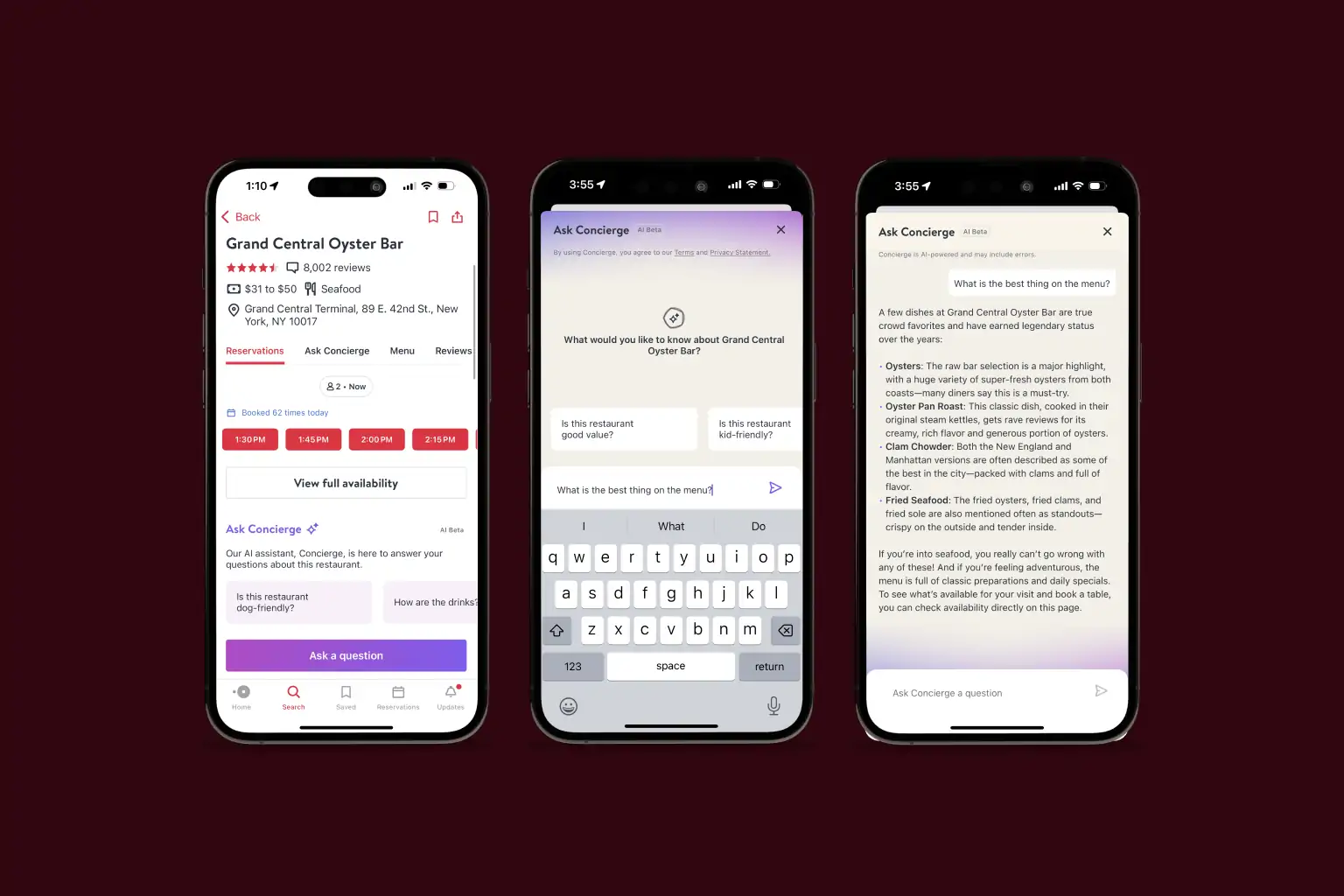Getting meaningful guest feedback through restaurant surveys isn’t always straightforward. Ask too many questions, and guests lose interest. Ask the wrong restaurant feedback questions, and you’ll miss valuable insights entirely. But ask the right questions at the right time, and your restaurant feedback survey becomes a powerful resource to enhance your dining experience and improve guest satisfaction so they keep coming back.
We show you exactly how to craft effective restaurant survey questions, plus tips for gathering and acting on valuable guest insights through restaurant listening surveys.
Why restaurant surveys matter
So, why use restaurant survey questions to find out more about your guests? Other than gauging their experience, there’s plenty you can take from getting first-hand insights.
Guest satisfaction encourages repeat visits
Restaurant surveys aren’t just about ticking boxes. They show guests you genuinely care about their dining experience. When diners feel heard, they’re far more likely to return. Asking restaurant feedback questions helps foster guest loyalty, turning occasional visitors into devoted regulars.
Understand exactly what your guests want
Every restaurant owner wants to know what their guests truly think, but relying on guesswork is risky. Using targeted restaurant survey questions gives you actionable insights directly from your diners, clarifying their preferences, expectations, and tastes. This lets you make data-driven decisions, from menu changes to service enhancements, so you’re always meeting—or exceeding—guest expectations.
Fix issues before they become bigger problems
No restaurant is perfect, and small issues can escalate quickly if not addressed in a timely manner. Conducting regular restaurant listening surveys allows you to catch problems early—whether it’s a service misstep, food quality concern, or atmosphere issue—and resolve them proactively. Handling these matters swiftly prevents negative reviews and keeps your restaurant’s reputation intact.
Types of restaurant survey questions
Not all restaurant survey questions are created equal, with each type providing a different kind of insight. Depending on what you’re looking to achieve, your restaurant feedback survey can cover a variety of areas:
General restaurant feedback questions
These questions capture overall guest sentiment about your restaurant. They measure general satisfaction, likelihood of recommending to others, and overall guest experience.
Example question: How likely are you to recommend our restaurant to a friend or colleague on a scale from 1 to 10?
Food quality survey questions
Since food is the heart of your restaurant, these questions explore guest perceptions around taste, freshness, presentation, dietary preferences, and value for money.
Example question: How would you rate the freshness and quality of your meal today?
Service feedback questions
Great food needs great service. Restaurant survey questions around service assess guest interactions with your staff, server attentiveness, friendliness, and responsiveness to requests.
Example question: How attentive and helpful was your server during your visit?
Ambiance and comfort questions
Guests don’t just visit for the food. They want a comfortable, enjoyable atmosphere, and ambiance-focused restaurant feedback questions measure everything from comfort and décor to lighting, cleanliness, noise levels, and overall atmosphere.
Example question: How comfortable did you find the seating and overall atmosphere of the restaurant?
Reservation and booking questions
Smooth reservations create excellent first—and lasting—impressions. These questions gather insights about the ease of making bookings or how guests feel about wait times, as well as reservation accuracy and communication effectiveness.
Example question: How easy was it to book a reservation with us?
Takeout and delivery questions
With more guests opting for takeout and delivery, you might want to understand their off-premises dining experience. These restaurant survey questions evaluate ordering ease and accuracy, as well as food freshness, packaging quality, and delivery timeliness.
Example question: Was your takeout order accurate and ready on time?
Best practices for restaurant surveys
Follow these tips if you want to nail your restaurant survey questions and get the type of feedback from guests that can turn your spot into the go-to place around town.
Keep it short and sweet
Respect your guests’ time. That’s the golden rule of restaurant survey questions. Studies show that a 10- to 20-minute survey gets a response rate of 30%, while a 30-to 60-minute one has just an 18% success rate.
Aim for five to ten questions max. Any more and you risk survey fatigue, which leads to rushed or incomplete responses. And make most questions multiple choice or rating scales to keep things quick. Leave room for one or two open-ended questions at the end for more detailed feedback.
Focus on what matters most
Zero in on the areas that have the biggest impact on guest satisfaction and your bottom line. For most restaurants, that means aspects like food quality, service, ambiance, and value. Avoid questions about minor details that won’t actually inform your decision-making.
For instance, don’t ask guests to rate the color of your napkins or the font on your menu. While these might seem important to you, they rarely make or break a dining experience. Instead, focus on insights that reveal how your food tastes, if your servers are attentive, and whether guests feel they got good value for their money. These are the factors that keep people coming back—or send them to your competitors.
Use a mix of question types
Rating scales (one to five or ten) are great for measuring overall satisfaction. Multiple choice works well for specific preferences in your restaurant survey questions, while open-ended responses allow guests to elaborate on their experience in their own words.
When thinking about questions to ask, stick to the tried and tested to begin with. For example, ask guests how likely they are to recommend you to a friend or colleague, or how they rate the overall dining experience.
When it comes to the food and drink, ask questions about the quality of the meal, the dishes they enjoyed the most, and if they thought they got value for money. It’s similar for service—look for insights around server attentiveness and if the food was served in a timely manner.
Also, look to get feedback from open-ended questions by asking guests about the best part of their dining experience, or what can be done on your end to make the visit even better. These questions give you a good starting point so you can get to know guests’ sentiments about their experience while dining at your restaurant.
Customize for your concept
While the questions around dishes and value for money work for most restaurants, consider adding one or two that speak to your unique concept or offerings.
- For a wine bar: How knowledgeable was your server about our wine selection?
- For a family restaurant: How kid-friendly was your experience?
- For a farm-to-table spot: How important is our use of local ingredients to you?
Crafting the survey so it asks unique questions will give you more insights into what makes your restaurant stand out over other local spots.
Timing is everything
But avoid interrupting their meal with tableside surveys—let them enjoy their time with you. Instead, send your survey within 24 to 48 hours of a guest’s visit, while the experience is still fresh.
Many restaurants find success with post-visit email surveys. If you use a reservation system like OpenTable or a loyalty program, you likely already have guest email addresses on file. Just be sure to follow data privacy laws in your area.
Make it easy to complete
Whether you’re using paper comment cards or digital surveys, the easier you make it for guests to give feedback, the more responses you’ll get. See to it that digital surveys are mobile-friendly since many guests will open them on their phones.
You might also decide to offer a small incentive to boost survey response rates, like 10% off their next visit. But be wary of incentives that are too large, as they may skew results by attracting only deal-seekers.
Act on the feedback
The most important part of any survey is what you do with the results. Set up a system to review feedback, identify trends, and create action plans. Share both positive and constructive feedback with your staff too.
Put those survey results to work. Maybe you’ll discover it’s time to revamp that appetizer everyone’s skipping, or coach your servers on being more attentive. You might even decide to dim the lights a notch based on ambiance feedback.
When guests notice these improvements on their next visit, they’ll feel heard—and be more likely to share their thoughts again. It’s a win-win: you get valuable insights, and they get a better dining experience.
Close the loop
When possible, respond to survey feedback. This is especially true for resolving issues raised by unsatisfied guests. A personal follow-up can turn a negative experience into a positive one and create a loyal guest.
For particularly glowing reviews, consider asking permission to use quotes in your marketing materials. Testimonials from real guests offer validation and act as excellent social proof for attracting new customers.
Keep evolving your survey
Your business changes over time, and your survey should, too. Revisit your questions periodically so they’re still giving you the insights you need. As you make improvements based on feedback, you may want to add questions to gauge the impact of those changes.
Don’t be afraid to experiment with new question formats or topics. Try a seasonal question about your summer menu, or ask about a new service you’ve introduced, for example. Aim to keep your survey as dynamic and responsive as your restaurant so you and your guests stay engaged in the feedback process.
Sample surveys to get you started
Here are two sample survey formats: one short, one more detailed. You can use these as starting points and customize to fit your specific restaurant and guest base.
Quick 5-question survey:
- How likely are you to recommend [restaurant name] to others? (1-10 scale)
- What did you enjoy most about your visit? (Multiple choice: Food, Service, Atmosphere, Value, Other)
- How would you rate the quality of your meal? (1-5 stars)
- How attentive was your server? (1-5 stars)
- Is there anything we could improve? (Open-ended)
More detailed 10-question survey:
- How likely are you to recommend [restaurant name] to others? (1-10 scale)
- How would you rate your overall dining experience? (1-5 stars)
- What was the primary reason for your visit? (Multiple choice: Regular meal, Special occasion, Business, Other)
- How would you rate the quality of your meal? (1-5 stars)
- Which dish did you enjoy most? (List menu items)
- How attentive was your server? (1-5 stars)
- How would you rate the atmosphere/decor? (1-5 stars)
- How was the value for the price? (1-5 stars)
- What was the best part of your experience? (Open-ended)
- Is there anything we could have done to improve your visit? (Open-ended)
How to effectively share your restaurant feedback survey
Getting feedback from your guests shouldn’t feel like a hassle, for you or for them. Here are some easy and effective ways to share your restaurant feedback survey and capture insights your restaurant can actually use.
Send a quick post-meal email
Drop a short, friendly email survey into your guests’ inboxes within a day or two of their visit. It’s low-effort, high-impact, and lets diners reply when it suits them. Plus, you’re catching them while their experience is still fresh, ensuring authentic and useful responses.
Try SMS surveys for on-the-go feedback
Text message surveys are fast, straightforward, and perfect for guests on the move. Send a quick text shortly after a visit with a simple link, making it easy for diners to leave feedback right from their phones.
Integrate surveys right on your website
Add simple, engaging surveys directly onto your website, perfect for guests checking menus, booking tables, or ordering takeout online. It’s convenient, timely, and catches guests in the moment. You get feedback that’s fresh and accurate.
Capture insights with QR codes and on-premises tablets and kiosks
Make giving feedback part of the dining experience itself. Easily share your survey via a QR code that lives on a table tent or check insert. Setting up user-friendly tablets or kiosks near your restaurant’s exit, waiting area, or host stand is another great way to invite input. They’re easy, immediate, and perfect ways to capture guests’ first impressions before they walk out the door.
Taking action on restaurant feedback
Collecting restaurant feedback surveys is just the first step, but the real magic happens when you turn guest insights into meaningful changes. Here’s how to put your feedback to work.
Keep a close eye on guest feedback
Review your survey results so you’re always aware of what’s delighting guests (and what might need attention). Setting up a routine—whether weekly, bi-weekly, or monthly—helps your team stay responsive and proactive while being focused on creating great experiences.
Use insights to empower your staff
Share guest feedback directly with your team and use it as a tool for ongoing training. Positive comments can highlight what’s working well, while constructive feedback gives your staff clear, actionable areas for improvement. It’s a straightforward way to continually boost service quality and morale.
Make informed decisions to enhance your restaurant
Guest feedback can—and should—drive your operational decisions. Whether it means fine-tuning your menu or adjusting your reservation process, acting on guest preferences shows that you’re listening and engaged. And when guests notice these changes on their next visit, it builds loyalty and trust for your restaurant.
Beyond traditional surveys
While formal surveys are valuable, don’t overlook other sources of guest feedback. Monitor your online reviews, social media mentions, and in-person comments from guests. Sometimes the most honest feedback comes when guests don’t feel like they’re being formally surveyed.
Consider using a reputation management tool to help you keep track of feedback across various platforms. You’ll be able to spot trends and respond promptly to both positive and negative reviews.
What’s the answer?
The goal of any restaurant survey is to better understand your guests so you can create experiences they’ll love. Ask the right questions and listen to the answers. As a result, you’ll gain important insights to help your restaurant thrive.
Ready to get the right type of insights for your restaurant? Check out OpenTable’s reputation management tools to streamline your survey process and get a holistic view of guest sentiment across multiple touchpoints.d get a holistic view of guest sentiment across multiple touchpoints.




